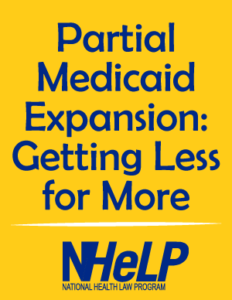 Why do something simply when you can spend more to get less? That appears to be exactly what Wisconsin has done when it chose its own path to expand Medicaid to some low-income adults. A new report from the non-profit Kids Forward underscores the fiscal illogic of Wisconsin’s approach. The state will spend $190 million more per year to cover 80,000 fewer people through its unique approach to Medicaid expansion.
Why do something simply when you can spend more to get less? That appears to be exactly what Wisconsin has done when it chose its own path to expand Medicaid to some low-income adults. A new report from the non-profit Kids Forward underscores the fiscal illogic of Wisconsin’s approach. The state will spend $190 million more per year to cover 80,000 fewer people through its unique approach to Medicaid expansion.
First, a bit of background. The Affordable Care Act (ACA) created a new catch-all adult coverage group for low-income people up to 133 percent of the federal poverty level (about $16,000 for an individual). Before the ACA, these folks couldn’t qualify for Medicaid. To avoid burdening tight state budgets, the federal government covered all the medical costs for new enrollees for three years, phasing down to 90 percent by 2020. For comparison, the normal federal match rate for Medicaid enrollees currently ranges from 50 to 75 percent, depending on the state.
 Back in 2014, Wisconsin’s Republican Gov. Scott Walker chose a different route. Wisconsin already covered parents with incomes up to 133 percent. But rather than extending coverage to childless adults to the same level, his administration sought a special waiver from the Medicaid law, known as a Sec. 1115 project, to set a 100 percent FPL limit for all adults ($12,060/individual; $24,600/family of four). Outside the 1115 waiver, the state cut traditional coverage for parents to 100 percent FPL. Adults earning more could get federal tax credits to help pay for Marketplace health insurance. CMS approved this 1115 “partial expansion” project, but not with the enhanced federal match rate. Instead, Wisconsin pays just over 41 percent of medical costs for its new expansion enrollees (and federal taxpayers pick up the rest).
Back in 2014, Wisconsin’s Republican Gov. Scott Walker chose a different route. Wisconsin already covered parents with incomes up to 133 percent. But rather than extending coverage to childless adults to the same level, his administration sought a special waiver from the Medicaid law, known as a Sec. 1115 project, to set a 100 percent FPL limit for all adults ($12,060/individual; $24,600/family of four). Outside the 1115 waiver, the state cut traditional coverage for parents to 100 percent FPL. Adults earning more could get federal tax credits to help pay for Marketplace health insurance. CMS approved this 1115 “partial expansion” project, but not with the enhanced federal match rate. Instead, Wisconsin pays just over 41 percent of medical costs for its new expansion enrollees (and federal taxpayers pick up the rest).
The results of this approach are not promising. Overall, the KidsForward report notes that while Wisconsin’s uninsurance rates fell after 2014, rates in neighboring full expansion states fell more.
 More specifically, the 2014 coverage cuts for parents dropped nearly 63,000 adults from BadgerCare, Wisconsin’s name for Medicaid. Fewer than 6 in 10 later found other types of coverage. More than 26,000 likely became uninsured.
More specifically, the 2014 coverage cuts for parents dropped nearly 63,000 adults from BadgerCare, Wisconsin’s name for Medicaid. Fewer than 6 in 10 later found other types of coverage. More than 26,000 likely became uninsured.
Fewer covered parents means fewer covered kids. Not surprisingly, Wisconsin slid from 12th best state for child uninsurance in 2013 to 20th in 2016. According to state’s Legislative Fiscal Bureau, the state could have insured more people, and saved $1.07 billion through 2019, if it have accepted a traditional expansion.
Given these numbers, no other state has followed Wisconsin’s awkward lead on partial expansion. However, two expansion states, Arkansas and Massachusetts, have proposed rolling back expansion coverage to 100% FPL. Unlike Wisconsin, these states seek to keep their enhanced federal match. This dangerous proposal would be a losing proposition for the federal government and for Medicaid-covered adults.
Arkansas now pays part of the costs to cover expansion adults in its Marketplace. Essentially, the state proposes to shift those state costs onto the federal government and also forego its responsibilities to provide Medicaid consumer protections and cost sharing protections for expansion adults over the poverty level. Massachusetts would also shift expansion costs to the federal government (and to enrollees, who would face higher out-of-pocket expenses). Neither proposal offers a meaningful upside.
If these two states get what they want, other governors will trample down the doors looking for the same deal. Wisconsin, no doubt, would lead the way. The result? More uninsured low-income parents and childless adults, fewer covered children, higher out-of-pocket costs, and higher federal costs for covered adults. Remember, Medicaid is considerably cheaper than Marketplace coverage, and costs grow more slowly. So shifting adults from Medicaid to the Marketplace costs the federal government (and covered adults) more. Back when the ACA was passed, RAND estimated that setting Medicaid eligibility at 133 percent FPL would cost the federal government $5 billion less (and cover 1 million more people) than setting the expansion threshold at 100 percent FPL.
In sum, partial Medicaid expansion gives us less, but costs more. Low-income families lose out with higher coverage costs and fewer stay insured. The federal government loses too, at least if it offers enhanced match for partial expansion. Hopefully, CMS will pay attention to this data and reject these partial expansion proposals.
